When you see most of the firefinch family, there’s little doubt how these small Estrildid finches got their name – their bright red plumage. There are a total of eleven species in the family, which has the Latin name Lagonosticta, some of which are found in captivity with others less so.
Red-billed firefinch
Perhaps the most frequently found member of the family in the UK is the Red-billed Firefinch, also known as the Senegal firefinch (L. senegala). This finch is around 10cm in length with the male being almost totally red in his plumage, save his wings that are a reddish-brown shade as are some of his tail feathers. His mate isn’t as brightly coloured, being mostly brown with a red eye stripe and tail. Both birds have a pink beak and yellow eye ring.
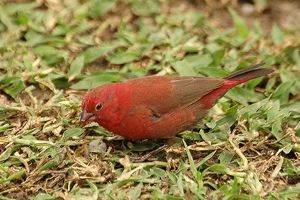
In captivity, they are also able to live with other species though their small size means that consideration needs to be given to bar spacing or mesh size so they can’t escape. Due to their African heritage, they will also require heating and protection from the elements during the colder months. They will live on a quality foreign seed mix along with mealworms, waxworms and other live food when they are raising their young.
If available, they will build a nest in a low growing shrub where they make a dome-shaped nest with a side opening. They don’t like their nest interfered with, so resist the urge to make nest inspections. As many as three clutches a year may be raised with 3-4 eggs in each. Incubation lasts for 11-12 days then the chicks fledge at 18-21 days. They are sexually mature by 9 months but shouldn’t be bred themselves until at least a year old.
African firefinch
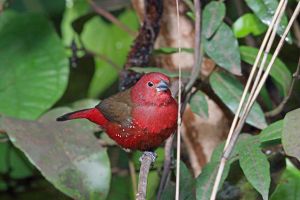
The African firefinch is said to be hardier than the Red-billed though heat and protection from the elements is always advisable for any non-native bird from a warmer climate – they simply don’t have a dense enough feather structure to survive our climate. They are described as peaceful and somewhat shy birds that live well with others. They will often live in family groups.
In captivity, their feeding and breeding requirements are much the same as their Red-billed cousin.
Black bellied firefinch
The Black bellied firefinch (Lagonosticta rara) is often described as the most beautiful and most challenging of the species found in captivity. They are sexually dimorphic so telling male from female is easy – the male is a deep wine red with dark brown and black on both the wings and the tail. Their beaks are two shades – black on the upper mandible and pink or red on the lower. The female is mostly a pale pinkish brown.
These birds are said to be nervous and shy birds, best living in a well planted aviary that allows them to hide and feel safe. They need heat and protection from the elements due to their African heritage and otherwise feed and breed much as the other species.
Other species
The Jameson’s firefinch (L. rhodopareia) looks similar to the Red-billed species with a crimson red body colour, dark brown wings and black tail feathers. The female is similar but paler in shade apart from her tail feathers that are still bright red and black. They are found across central and southern Africa. In captivity, they are friendly and reserved birds that spend a lot of time on the ground foraging for their food.
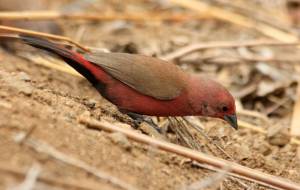
The Bar-breasted firefinch (L. rufopicta) is also called the Speckled Firefinch and has black feathers from the back and upper winds changing to brown on the rump and upper tail coverts that are red. It is found in central Africa where is lives in the grasslands and savannah areas, often near human habitation.
Despite its name, the Brown firefinch (L. nitidula) isn’t really that brown – it has red feathers on its face and upper breast then speckled flanks and a brown body and tail. It is found across parts of west and south-western Africa where it occupies the reed beds, tall grassland and papyrus areas.
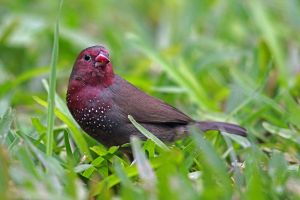
The Rock firefinch (L. sanguinodorsalis) is found to the northern parts of Nigeria and has a red back, breast and upper tail as well as face while its wings are brown and the end of the tail is black. The female’s colouration is more towards brown than red. It lives in rocky hillsides and uses granite outcroppings to roost and nest close to thickets and grassland areas.
The Chad firefinch (L. umbrinodorsalis) is also known as the Reichenow’s firefinch and is found across a limited area in Central Africa known as the East Sudanian Savanna ecoregion. It lives in areas with rocky hillsides and savannah as well as tall grasses. The male bird is bright pinkish red with a grey nape and crown as well as a dark grey bill. Females are a little duller in the colouration. They were once thought to be a subspecies of the Jameson’s firefinch but are now separate.
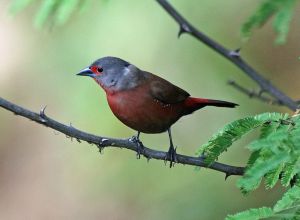

I am finchbird firmer. i interest about this